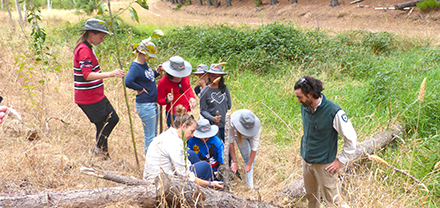
Tatachilla Lutheran College students work with Department of Environment and Water Senior Ecologist Elisa Sparrow and ForestrySA Ranger Lennan Whiting to install a motion-detection camera within Southern Brown Bandicoot habitat in the Kuitpo Forest Reserve.
ForestrySA is working to protect endangered bandicoots living within the Kuitpo Forest Reserve as part of an eco-education collaboration with local school students. Source: Timberbiz
The nationally endangered Southern Brown Bandicoot (Isoodon obseulus) was rediscovered living in the forest in early 2018 – the first sighting since the Ash Wednesday bushfires in 1983. Source: Timberbiz
Students from McLaren Vale’s Tatachilla Lutheran College are assisting in the ongoing monitoring and protection of the typically shy marsupial.
As part of the monitoring program, participating students were briefed by Department for Environment and Water Senior Ecologist Dr Elisa Sparrow, before installing a motion detection camera on ForestrySA land near Kangarilla.
The camera was positioned within bandicoot habitat located in a degraded drainage line overgrown with declared noxious weeds Periwinkle and Blackberry. While both plant species are declared weeds, they provide effective coverage for the bandicoot and vital protection from predators such as foxes and feral cats.
Within just weeks, two bandicoot sightings were captured on camera, much to the excitement of the students.
According to ForestrySA Ranger Lennan Whiting, the latest bandicoot sightings increase understanding of its distribution within the Kuitpo Forest and provide confirmation the Bone Gully drainage line is being used as habitat. It also supports a ForestrySA conservation initiative to establish a buffer zone during future harvest operations in nearby pine plantation.
“As part of our long-term, post-clearfall plan, the creek-line will be rehabilitated with local heath species to provide habitat and protection from predators,” Mr Whiting said. “A biodiversity corridor will also be established, linking up isolated known bandicoot habitat areas through the forest in to adjacent private lands.
“The project will be completed in stages, preserving the existing weedy habitat until the native vegetation replacement is properly established.”







